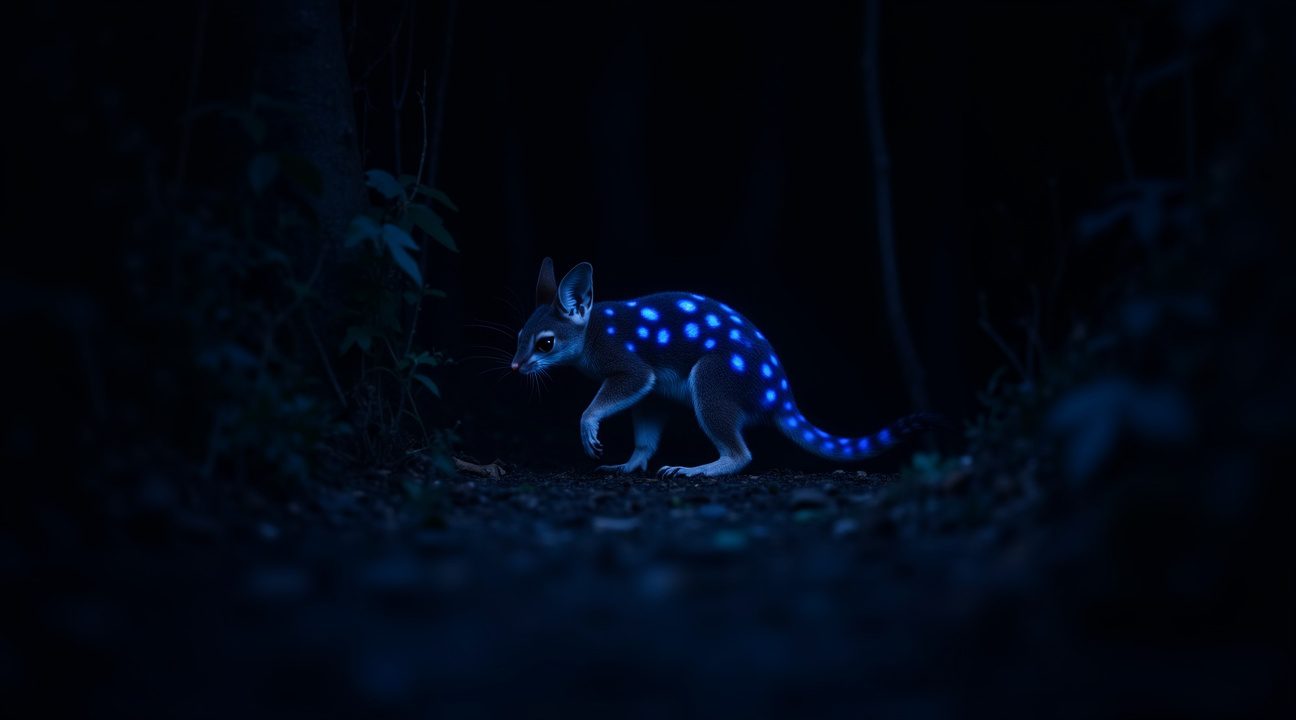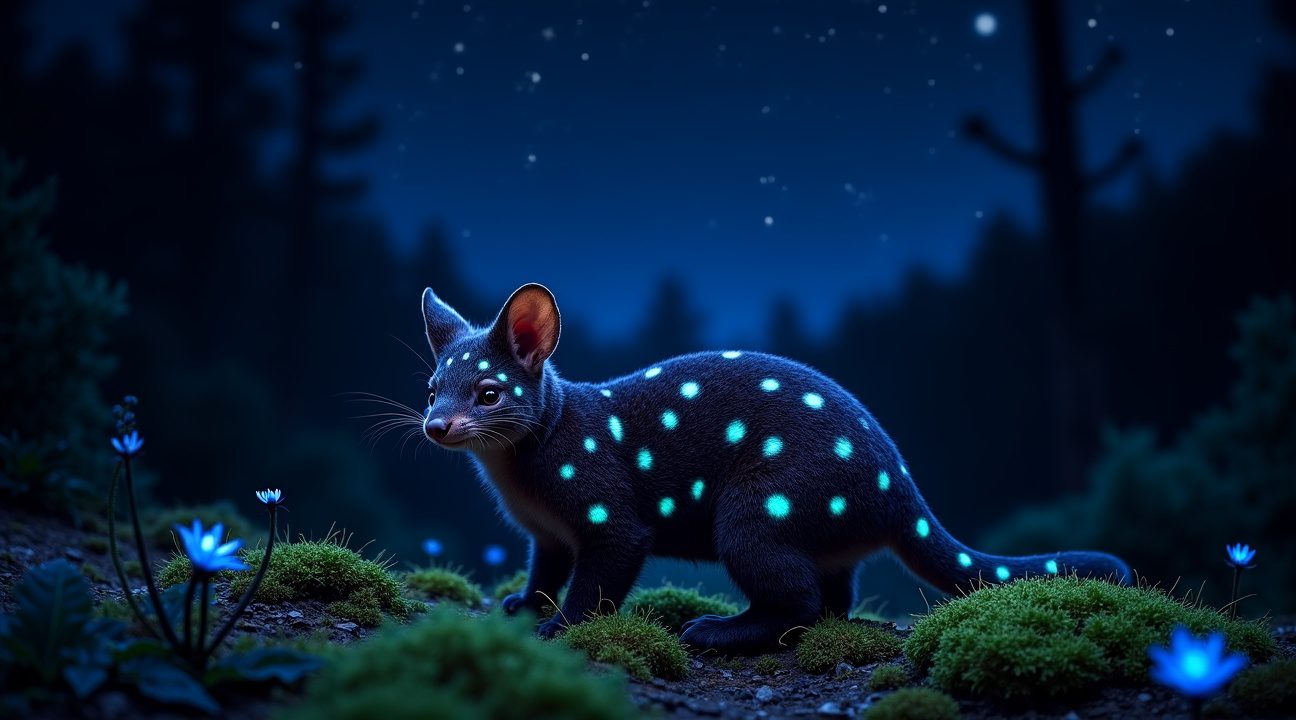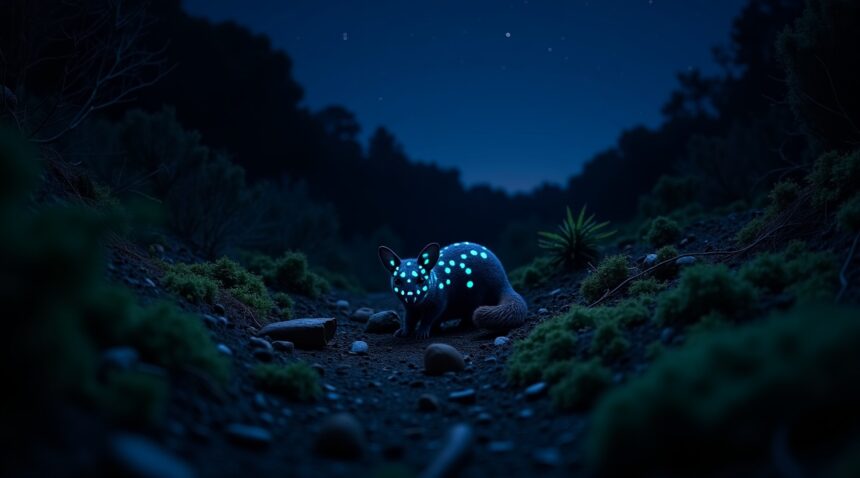Photographer Ben Alldridge has captured groundbreaking images of eastern quolls displaying brilliant blue biofluorescence under ultraviolet light in Tasmania. This discovery marks the first documented case of a marsupial exhibiting natural fluorescence in the wild. The endangered eastern quoll now joins an extremely select group of mammals known to possess this extraordinary trait, creating fresh research opportunities in marsupial biology and evolutionary adaptations.
Key Takeaways
- Eastern quolls display vivid blue fluorescent spots under UV light, making them one of only a handful of mammalian species known to exhibit biofluorescence in the wild.
- The discovery required specialized UV photography equipment and techniques, representing a significant technical breakthrough in wildlife documentation.
- Scientists remain uncertain about the biological function of this trait, with theories ranging from species communication and mate recognition to camouflage and territorial marking.
- The visual documentation has significantly boosted conservation awareness for this endangered species, with the photographs earning recognition at prestigious science photography competitions.
- This finding suggests many other nocturnal mammals may possess hidden fluorescent traits that remain undetected without UV examination, potentially revolutionizing understanding of mammalian adaptations.
Further Reading and Conservation Efforts
Learn more about this fascinating discovery through Ben Alldridge’s official site and conservation programs such as The Nature Conservancy Australia, which work to protect species like the eastern quoll. As interest in these glowing creatures grows, so does the urgency to preserve their habitat and continue this invaluable research.
Eastern Quoll Photographed Glowing Blue Under UV Light for First Time in Wild
The endangered eastern quoll (Dasyurus viverrinus) has captured scientific attention in an extraordinary way after being photographed displaying stunning biofluorescence in its natural Tasmanian habitat. Photographer Ben Alldridge achieved what no one had documented before — capturing verifiable images of these rare marsupials glowing with brilliant blue spots under ultraviolet light in the wild.
This groundbreaking documentation represents a significant milestone for both wildlife photography and marsupial research. Under normal lighting conditions, eastern quolls appear with their characteristic fawn or black fur adorned with distinctive white spots. However, when exposed to UV illumination, these endangered creatures transform into living jewels, displaying a vivid blue glow that highlights their spotted patterns with remarkable intensity.
Technical Breakthrough in Wildlife Photography
Alldridge’s success required sophisticated equipment and innovative techniques to capture this elusive phenomenon. He employed UV-modified flashes combined with specialized cameras including the SONY ILCE-7M3 and Canon EOS 5D Mark IV, paired with high-sensitivity lenses capable of detecting fluorescent emissions. The technical challenges of photographing biofluorescence in wild animals demanded precise timing and environmental conditions, making these images particularly valuable to the scientific community.
The fluorescent properties manifest most prominently at the spots and certain fur patches, creating patterns that differ significantly from the animal’s appearance under visible light. This blue fluorescent fur represents a rare biological phenomenon among marsupials, with eastern quolls joining a select group of mammals known to exhibit natural biofluorescence.
The discovery adds another layer of intrigue to these already fascinating creatures, which share some remarkable traits with other intelligent marine life. Just as researchers continue to study octopus intelligence and the cognitive abilities of various species, this fluorescent trait opens new avenues for understanding marsupial biology and evolution.
Tasmania’s unique ecosystem continues to reveal surprises, much like recent discoveries in other remote locations. While scientists have found deep-sea fish at extreme depths, the eastern quoll’s biofluorescence represents an equally remarkable find closer to the surface.
The implications of this discovery extend beyond simple curiosity. Understanding why eastern quolls exhibit this trait could provide insights into their behavior, communication methods, and evolutionary adaptations.
Some researchers speculate that biofluorescence might serve several purposes:
- Species recognition among quolls
- Territorial marking or mating communication
- Camouflage or predator deterrence under specific light conditions
Though these theories remain unconfirmed, they highlight the importance of investigating this phenomenon further.
The timing of this discovery proves particularly significant given the eastern quoll’s endangered status. These marsupials face numerous threats in their native habitat, making every new piece of biological information crucial for conservation efforts. The fluorescent properties might represent an unknown aspect of their ecology that could influence future protection strategies.
Alldridge’s work demonstrates how advancing photographic technology continues to reveal hidden aspects of wildlife biology. UV-sensitive photography techniques, once limited to laboratory settings, now allow researchers and photographers to document natural phenomena that would otherwise remain invisible to human observation.
The eastern quoll’s blue glow joins other recent scientific discoveries that challenge our understanding of life on Earth. From Saturn’s moon containing building blocks for life to the return of blue whales to Philippine waters, nature continues to surprise scientists with unexpected revelations.
This documentation of Dasyurus viverrinus under UV light represents more than just stunning photography — it opens new research directions for understanding marsupial biology and the role of biofluorescence in mammalian species. The images serve as both scientific evidence and conservation tools, highlighting the importance of protecting Tasmania’s unique wildlife before more secrets disappear with extinction.
Rare Phenomenon Among Mammals Adds to Scientific Knowledge
The discovery of biofluorescence in the eastern quoll represents a remarkable addition to the extremely limited cases documented among mammals. While hundreds of marine species display this fascinating trait, including corals, fish, and various invertebrates, finding it in mammals remains exceptionally uncommon and scientifically significant.
Limited Mammalian Cases Create Scientific Intrigue
Scientists have previously identified biofluorescent capabilities in only a handful of mammalian species. Polar bears, flying squirrels, and platypuses have shown varying degrees of this phenomenon, while other Australian marsupials including wombats, Tasmanian devils, and kangaroos have also demonstrated fluorescent properties. Armadillos and echidnas round out this exclusive group, with even some cockatoos displaying similar characteristics.
Each species exhibits unique patterns and wavelengths, making the eastern quoll’s bright blue spots particularly distinctive. The comparative rarity among mammals contrasts sharply with marine environments, where biofluorescence appears widespread across numerous species families. This disparity highlights why every new mammalian discovery carries substantial scientific weight.
Biological Mechanisms Under Investigation
Researchers believe specific proteins or pigments within the eastern quoll’s fur absorb ultraviolet light and re-emit it as visible blue wavelengths. This process, while well-understood in marine organisms, remains under active investigation for mammalian species. Scientists continue exploring whether the mechanism serves evolutionary purposes such as communication, camouflage, or mate selection.
The biological complexity of mammalian biofluorescence differs significantly from simpler organisms. Mammalian fur structure, combined with varying protein compositions, creates unique challenges for researchers attempting to understand the underlying chemistry. The eastern quoll’s distinct blue emission pattern may provide crucial insights into how this phenomenon evolved independently across different mammalian lineages.
Current investigations focus on identifying the exact molecular components responsible for light absorption and emission. Scientists analyze fur samples under controlled laboratory conditions, comparing fluorescent mammals with non-fluorescent relatives to isolate the specific biological factors. These studies could reveal whether biofluorescence serves functional purposes or represents an evolutionary quirk with minimal survival advantages.
The eastern quoll’s contribution to scientific understanding extends beyond simple documentation. Each new mammalian case helps researchers build comprehensive models of how and why this phenomenon occurs across different species groups, potentially uncovering broader principles about animal adaptation and sensory communication systems.
Photography Techniques Reveal Hidden Wildlife Adaptations
I discovered that documenting the eastern quoll’s remarkable biofluorescence demanded cutting-edge photographic equipment and specialized techniques that pushed the boundaries of wildlife photography. Researchers utilized high-end camera systems, specifically the SONY ILCE-7M3 and Canon EOS 5D Mark IV, paired with exceptionally sensitive lenses designed to capture the faintest traces of fluorescent emission. These cameras proved essential for detecting the subtle blue glow that emerges when UV light strikes the quoll’s fur.
Specialized Equipment and Dark-Field Photography
The photography sessions required UV-modified flash systems that could emit the specific wavelengths needed to trigger the animal’s biofluorescent response. Photographers conducted shoots in completely dark conditions, eliminating all ambient light sources to maximize the visibility of the UV-induced fluorescence. This approach created stark contrasts that allowed the blue spots to appear vividly against the quoll’s natural fur coloration.
Camera settings demanded extreme sensitivity adjustments, with ISO levels pushed to their limits while maintaining image quality. The high-sensitivity lenses captured photons that would otherwise remain invisible to standard photography equipment. Each shot represented a delicate balance between exposure time and light intensity, ensuring the fluorescent patterns appeared clearly without overexposing the surrounding fur.
Scientific Documentation and Research Applications
This photographic documentation formed part of a comprehensive research initiative investigating light pollution’s impact on nocturnal animal behavior. Scientists recognized that understanding how artificial lighting affects animals requires first documenting their natural light-related adaptations. The eastern quoll’s biofluorescence provided an unexpected window into these hidden characteristics.
The resulting images created a globally significant scientific record that showcases phenomena in wild mammals rarely observed or studied. These photographs serve multiple research purposes, from behavioral studies to evolutionary biology investigations. Just as researchers have made remarkable discoveries about deep-sea creatures in extreme environments, this UV photography reveals adaptations that exist right under our noses.
UV-sensitive photography techniques enable scientists to visualize hidden adaptations that animals have developed over millions of years. The blue fluorescent spots might serve communication purposes, territorial marking, or mate recognition functions that remain active even when humans can’t perceive them. Similar to how intelligent marine animals display complex behaviors, the eastern quoll’s biofluorescence suggests sophisticated biological systems operating beyond human visual perception.
The photographic methods developed for this project now provide templates for studying other potentially biofluorescent marsupials. Researchers can apply these techniques to investigate whether similar phenomena exist in related species or other nocturnal mammals. The documentation process itself has become as valuable as the discovery, offering reproducible methods for future wildlife photography projects.
These images represent more than scientific curiosity—they demonstrate how advanced photography can reveal evolutionary adaptations that challenge our understanding of animal sensory systems. The eastern quoll’s fluorescent spots remind us that nature operates across light spectrums we rarely consider, and that modern technology can bridge the gap between human perception and biological reality.

Unknown Function Raises Questions About Nocturnal Animal Behavior
The discovery of biofluorescence in eastern quolls has opened a fascinating new chapter in understanding how nocturnal animals might communicate and adapt to their environment. Scientists currently can’t explain why these endangered marsupials glow under UV light, creating an intriguing mystery that challenges our assumptions about nighttime animal behavior.
Potential Roles in Communication and Survival
Several hypotheses attempt to explain this phenomenon, though none have received definitive scientific validation. Researchers propose that biofluorescence might serve as a form of communication between eastern quolls, allowing them to identify each other in low-light conditions when traditional visual cues become less effective. This light-based signaling could play a crucial role in mate attraction, helping individuals locate potential partners across Tasmania’s rugged terrain.
Camouflage represents another compelling possibility. The blue fluorescent spots might help eastern quolls blend with their surroundings under specific lighting conditions, providing protection from predators or improving their hunting success. Some scientists suggest that this adaptation could make them less visible to certain predators while maintaining visibility to their own species, creating a selective advantage in survival scenarios.
The ecological adaptation aspect raises questions about how these animals perceive their environment differently than humans imagine. Eastern quolls might possess enhanced light sensitivity that allows them to detect and respond to fluorescent signals invisible to most other creatures. This understanding evolution through unique adaptations demonstrates nature’s complexity in developing specialized traits.
Research Directions and Scientific Implications
The unknown function of biofluorescence in eastern quolls has prompted researchers to reconsider how nocturnal behavior patterns might include light-based elements previously overlooked. Scientists now question whether other Tasmanian wildlife possesses similar hidden adaptations that remain undetected without UV examination. This discovery suggests that our understanding of marsupial ecology might be incomplete, missing crucial communication methods or survival strategies.
Future scientific research must focus on studying the visual capabilities of both eastern quolls and their ecosystem partners. Researchers need to determine whether these animals can actually see UV light and respond to fluorescent signals from other individuals. Understanding the light sensitivity of their predators and prey could reveal whether biofluorescence provides genuine survival advantages or represents an evolutionary quirk with minimal functional impact.
Investigation into nocturnal behavior patterns might reveal timing correlations between fluorescent intensity and specific activities like mating, territory marking, or hunting. Scientists could monitor wild populations using UV cameras to document whether fluorescent displays change based on seasonal patterns, age, or health status. Such research could unlock insights into whether this trait actively influences eastern quoll social dynamics.
The broader implications extend beyond marsupials to other nocturnal species that might possess similar hidden characteristics. This discovery encourages researchers to examine whether other unique animals display biofluorescence as an adaptation to their specific environmental pressures. Scientists must consider how light pollution and habitat destruction might affect animals that rely on natural UV environments for communication or navigation.
Current research limitations include the challenge of studying endangered populations without causing additional stress to already vulnerable eastern quoll communities. Researchers must balance scientific curiosity with conservation priorities, ensuring that investigation methods don’t compromise the species’ recovery efforts. Laboratory studies might provide controlled environments for testing hypotheses, but they can’t replicate the complex ecological interactions that shape wild behavior patterns.
The mystery surrounding eastern quoll biofluorescence highlights how much scientists still don’t understand about nocturnal animal adaptations. Each new discovery reveals additional layers of complexity in ecological relationships, suggesting that many species might possess specialized traits that remain invisible to conventional research methods. This unknown function continues to challenge researchers to develop innovative approaches for studying the hidden lives of endangered species.
Discovery Boosts Conservation Awareness for Endangered Species
I recognize how scientific discoveries can transform conservation efforts, especially when they capture public imagination through striking visual evidence. The eastern quoll’s biofluorescent properties have created exactly this type of breakthrough moment for endangered species advocacy.
Currently classified as endangered, the eastern quoll exists primarily in Tasmania after its population experienced dramatic decline across mainland Australia. This marsupial’s precarious status makes every conservation effort critical, yet traditional wildlife protection campaigns often struggle to generate sustained public interest. The recent documentation of the quoll’s blue-spotted biofluorescence under UV light has changed that dynamic completely.
Media coverage and public fascination with these glowing images have elevated the eastern quoll from relative obscurity to conservation spotlight. The striking visual of blue spots emerging under ultraviolet illumination creates an immediate emotional connection that statistics alone cannot achieve. This discovery demonstrates how scientific research can unexpectedly provide powerful tools for species protection.
Science Photography Drives Conservation Messaging
The photograph documenting this biofluorescence earned recognition as a finalist in the 2025 Beaker Street Science Photography Prize, amplifying its conservation impact far beyond academic circles. Such prestigious acknowledgment transforms scientific documentation into compelling advocacy material that reaches diverse audiences.
Festival platforms like Beaker Street leverage these discoveries to educate visitors about animal intelligence and ecological uniqueness. Museum exhibitions incorporating this imagery create memorable experiences that connect visitors emotionally with conservation needs. These venues excel at translating complex research into accessible narratives that inspire action.
Public science engagement through visual storytelling proves particularly effective for endangered species conservation. When people discover that familiar animals possess extraordinary hidden characteristics, they develop stronger protective instincts. The eastern quoll’s biofluorescence exemplifies how evolutionary adaptations continue to surprise researchers and captivate public attention.
Updated conservation assessments emphasize the eastern quoll’s vulnerability while highlighting how public outreach significantly influences protection outcomes. Wildlife organizations now incorporate this biofluorescence discovery into their educational materials, creating more engaging content for fundraising and awareness campaigns. Conservation success stories often trace back to moments when scientific discovery intersected with effective public communication, making this eastern quoll breakthrough particularly promising for long-term species protection efforts.
Visual Documentation Advances Understanding of Hidden Animal Traits
I find that the eastern quoll’s remarkable blue biofluorescence creates fascinating parallels with phenomena I’ve observed in marine environments. This discovery connects terrestrial mammals to a trait more commonly associated with ocean dwellers, where deep-sea fish have long captivated scientists with their glowing adaptations. The quoll’s fluorescent spots demonstrate that this biological feature extends far beyond aquatic ecosystems into mammalian species we’re only beginning to understand.
Scientific research has historically concentrated on non-mammalian biofluorescence because aquatic organisms exhibit these traits more frequently and visibly. Marine species like jellyfish and certain fish display fluorescence as survival mechanisms, yet I notice that mammalian research has lagged significantly behind. This gap in scientific literature becomes particularly apparent when considering how many terrestrial species might possess similar hidden characteristics that remain undetected without specialized UV photography.
Photography’s Role in Revealing Biological Secrets
Modern photographic techniques serve as essential scientific instruments for uncovering these concealed biological features. I observe that UV photography has become indispensable for documenting traits invisible to human perception. These visual tools allow researchers to capture evidence of biofluorescence that would otherwise remain completely hidden. Advanced imaging technology enables scientists to document and analyze fluorescent patterns with precision, creating permanent records for further study. Photography provides the foundation for comparative analysis between species, helping researchers identify patterns and evolutionary connections. Each captured image contributes valuable data to our understanding of mammalian adaptations we never knew existed.
The eastern quoll’s discovery suggests that many endangered mammals might harbor similar fluorescent traits waiting for documentation. I suspect that targeted UV surveys of other threatened species could reveal additional cases of mammalian biofluorescence, potentially changing how we approach conservation photography and species assessment. Just as octopus intelligence surprised researchers with its complexity, these hidden fluorescent traits could revolutionize our understanding of mammalian biology.
Conservation efforts benefit tremendously from such discoveries, as unique biological features often strengthen arguments for species protection. I recognize that documenting these rare characteristics provides powerful evidence for the irreplaceable value of endangered species like the eastern quoll. Visual documentation of biofluorescence adds another layer to conservation narratives, demonstrating that threatened animals possess scientific significance beyond traditional ecological roles.

Sources:
Greater Good Science Center – Rare Glowing Marsupial: Eastern Quoll Biofluorescence Captured in Tasmania
Fluroscape – A Quoll’s Life: Novel Biofluorescence in Dasyurids
Australian Photography – Glowing Quoll Image Leads 2025 Beaker Street Science Photography Prize Finalists
Nature – Eastern Quoll Biofluorescence (d41586-024-02574-6)
PetaPixel – Photographer Captures the Hidden Light of Animals
Snopes – Fluorescent Marsupial Photo
Instagram – Post by Ben Alldridge (C-w8wBzNqWo)


